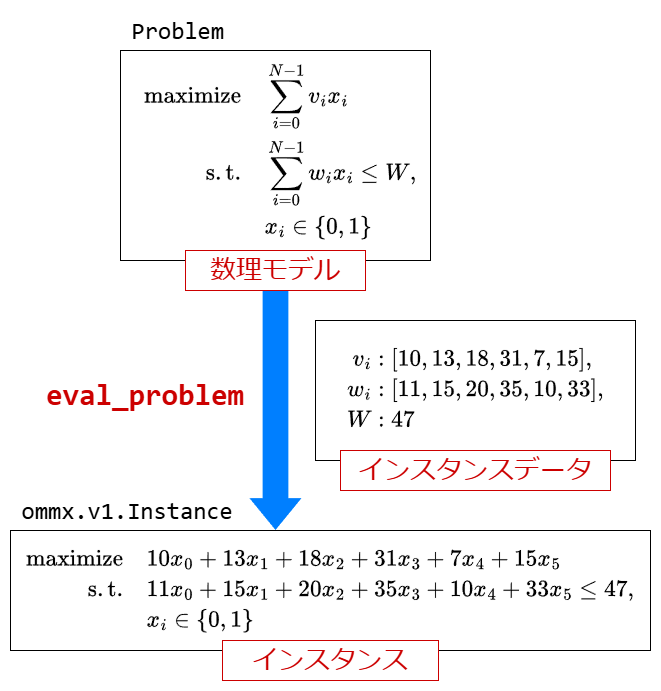Solving Optimization Problems with SCIP#
To understand how to use jijmodeling, let’s solve the knapsack problem on this page. However, since jijmodeling is a tool for describing mathematical models, it cannot solve optimization problems on its own. Therefore, we will solve it in combination with the mathematical optimization solver SCIP.
To use jijmodeling with SCIP, you need to install a Python package called ommx-pyscipopt-adapter (GitHub, PyPI). Please install it with the following command:
pip install ommx-pyscipopt-adapter
Problem Setting#
The knapsack problem can be formulated as a mathematical model as follows:
Hint
For more details on the formulation of the knapsack problem, please refer to here.
The meaning of each parameter in this mathematical model is as follows:
Parameter |
Description |
|---|---|
\(N\) |
Total number of items |
\(v_{i}\) |
Value of item \(i\) |
\(w_{i}\) |
Weight of item \(i\) |
\(W\) |
Weight capacity of the knapsack |
In this explanation, we will solve an instance obtained by inputting the following values into the parameters \(v_{i}, w_{i}, W\) of the above mathematical model:
Parameter |
Value |
|---|---|
\(v_{i}\) |
|
\(w_{i}\) |
|
\(W\) |
|
What is an instance?
In jijmodeling, an instance is a mathematical model with specific values assigned to its parameters.
Procedure for Generating an Instance#
Using jijmodeling, you can generate an instance to input into the solver in the following three steps:
Formulate the knapsack problem with
jijmodelingRegister instance data in the
InterpreterobjectConvert the mathematical model to an instance using the
Interpreterobject

Step1. Formulate the Knapsack Problem with JijModeling#
The following Python code formulates the knapsack problem using jijmodeling:
import jijmodeling as jm
# Value of items
v = jm.Placeholder("v", ndim=1)
# Weight of items
w = jm.Placeholder("w", ndim=1)
# Weight capacity of the knapsack
W = jm.Placeholder("W")
# Total number of items
N = v.len_at(0, latex="N")
# Decision variable: 1 if item i is in the knapsack, 0 otherwise
x = jm.BinaryVar("x", shape=(N,))
# Index running over the assigned numbers of items
i = jm.Element("i", belong_to=(0, N))
problem = jm.Problem("problem", sense=jm.ProblemSense.MAXIMIZE)
# Objective function
problem += jm.sum(i, v[i] * x[i])
# Constraint: Do not exceed the weight capacity of the knapsack
problem += jm.Constraint("Weight Constraint", jm.sum(i, w[i] * x[i]) <= W)
problem
Hint
For more details on how to formulate with jijmodeling, please refer to here.
Step2. Register Instance Data in the Interpreter Object#
Prepare the instance data to be input into the Placeholders of the mathematical model formulated in Step1, and register it in the Interpreter object.
You can register instance data by passing a dictionary with the following keys and values to the constructor of the Interpreter class:
Key: String set in the
nameproperty of thePlaceholderobjectValue: Data to be input
instance_data = {
"v": [10, 13, 18, 31, 7, 15], # Data of item values
"w": [11, 15, 20, 35, 10, 33], # Data of item weights
"W": 47, # Data of the knapsack's weight capacity
}
interpreter = jm.Interpreter(instance_data)
Step3. Convert the Mathematical Model to an Instance Using the Interpreter Object#
To convert the mathematical model to an instance, use the Interpreter.eval_problem method. By passing the Problem object to the eval_problem method of the Interpreter object with registered instance data, the Placeholder in the Problem object will be filled with the instance data and converted to an instance:
instance = interpreter.eval_problem(problem)
Hint
The return value of Interpreter.eval_problem is an ommx.v1.Instance object. For more details about it, please refer to here.
Solving the Optimization Problem#
Now, let’s solve the instance obtained in Step3 with the optimization solver SCIP. The following Python code can be used to obtain the optimal value of the objective function:
from ommx_pyscipopt_adapter import OMMXPySCIPOptAdapter
# Solve through SCIP and retrieve results as an ommx.v1.Solution
solution = OMMXPySCIPOptAdapter.solve(instance)
print(f"Optimal value of the objective function: {solution.objective}")
Optimal value of the objective function: 41.0
In addition, you can display the state of the decision variables as a pandas.DataFrame object using the decision_variables_df property of solution:
solution.decision_variables_df[["name", "subscripts", "value"]]
| name | subscripts | value | |
|---|---|---|---|
| id | |||
| 0 | x | [0] | 1.0 |
| 1 | x | [1] | 1.0 |
| 2 | x | [2] | 1.0 |
| 3 | x | [3] | 0.0 |
| 4 | x | [4] | 0.0 |
| 5 | x | [5] | 0.0 |
Hint
OMMXPySCIPOptAdapter.solve returns an ommx.v1.Solution object. For more information, see here.


